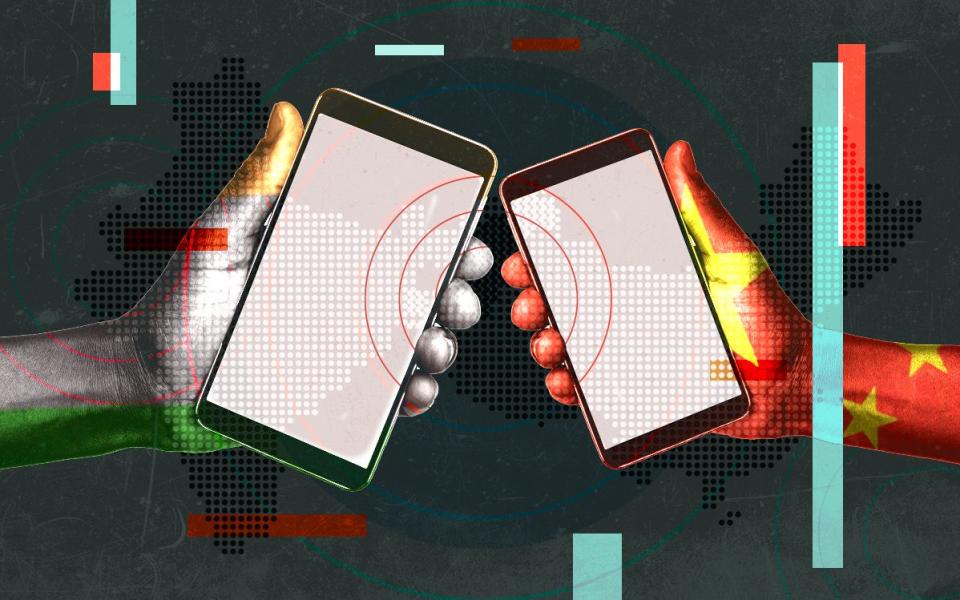How an India-China border skirmish turned into a technology war

When India and China squared off on the Doklam plateau on the border of Bhutan for 73 days in 2017, leaders Narendra Modi and Xi Jinping were keen for tensions not to escalate.
Three years later, and there is little such resolve between the two nuclear-armed states. Following a violent confrontation that took place in the Himalayan region of Ladakh on June 15, India raised the stakes by targeting a key area of Chinese might: technology.
On Monday, the ruling Bharatiya Janata Party (BJP) took steps to ban TikTok, the wildly popular Chinese-owned social media app with over 120 million users in India, along with 58 others from China, citing national security concerns and the “stealing” of data.
Nikhil Gandhi, the head of TikTok's India division, said the company “has not shared any information of its users in India with any foreign government”.
The move has widely been seen as retaliation from India following the death of 20 soldiers in the Ladakh border clash. But as a new frontier opens up in the ongoing tit-for-tat tussle between India and China, how exactly would a battle over technology play out between the two countries? Who really has the upper hand?
The ramifications of a rough and tumble in the technology arena are varied. For one, India serves as the largest foreign market for a number of China’s biggest tech players. Any move to scupper that stronghold could have significant financial consequences for those firms.
“There is a lot of nationalism and Modi talks about India needing to be self-reliant,” says Dr Gareth Price, senior research fellow of the Asia-Pacific Programme at Chatham House.
Given the “India first” impulse of the current regime, a continued move to ban Chinese-made tech products and apps like TikTok could offer momentum to recent boycott rallies on India’s streets calling for a ban on products that are “Made in China”.
Xiaomi started putting up "Made in India" banner outside their stores to counter "Boycott China" campaign. pic.twitter.com/vM7xHC0aij
— Raja Singh sewara (@rajasinghsewara) June 27, 2020
In recent days, storefronts across India featuring Xiaomi, one of China’s largest smartphone makers, have been replaced with banners that claim its phones are “made in India” to avoid becoming a victim of the protests.
Oppo, meanwhile, another Chinese smartphone maker, has seen anti-Chinese demonstrations take place outside a factory in the city of Greater Noida and was forced to cancel the online launch of its new flagship smartphone in the wake of the clashes.
For many Chinese companies like Xiaomi and Oppo, a sustained effort to target them could be a problem. Last year, Xiaomi generated $5bn (£4.04bn) in revenue in a country where the vast majority of people pay just a few dollars a month for phone contracts or pay-as-you-go sims and recent boycotts threaten to eat into its more than 30pc market share.
“It’s a bit of a threat to say to China, look we do have some leverage over you because we are a major consumer of your tech products,” Price says.
In the wake of the TikTok ban, which has taken a number of creators on the app by surprise, an alternative, Indian-made app known as Chingari has emerged, generating just over 2.5 million downloads in India since its launch in June.
The app, developed by two programmers in Bangalore in 2019, has quickly gained traction among young users and more senior citizens alike, with the underlying theme of countering China being the driver of downloads.
“I hadn’t ever downloaded TikTok but I have just downloaded Chingari...more power to you…” Anand Mahindra, the billionaire chairman and chief executive of the Mahindra Group conglomerate tweeted in response to an article about TikTok losing its “spark”.
Sanjeev Sanyal, an Indian economist and author, tweeted a similar sentiment, claiming to never have been into TikTok but that he had downloaded Chingari. “Content seems equally nutty...but is our nutty platform.”
But the strength of competitors in India could be a problem. Many users have complained that the TikTok alternative lacks some of the features boasted by the Chinese app.
“If you look down the armoury of what India can do to counter China, maybe discouraging Chinese tech, discouraging Chinese imports, but it's not a hugely convincing threat in the absence of alternatives,” Price says.
Other tech firms born in India have also become increasingly reliant on Chinese funds to keep them going. Paytm, a fintech firm backed by SoftBank, has also raised cash from Chinese firm Ant Financial, a payments arm of e-commerce giant Alibaba. Swiggy, a food delivery start-up, is backed by $600bn Chinese firm Tencent.
What complicates India’s assault on China further is its deep trade ties with the nation. Bilateral trade between the two was worth $92bn in 2019, but a trade deficit of over $56bn for India means it is heavily dependent on China to keep things going.
That deficit includes the import of key components for smartphones, for example, and could hamper the development of products in India that could legitimately compete with Chinese counterparts.
“The whole point of the ruling party in India is about being proud of being Indian,” Price says. “They're trying to push back on years of Indian stuff being labelled second rate.”

 Yahoo Finance
Yahoo Finance 